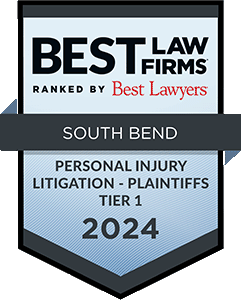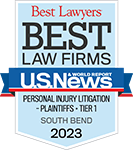Car crashes are stressful enough, but when the at-fault driver lies about the circumstances of the accident, the situation can quickly turn into a “he said, she said” situation. This article discusses how a dishonest, at-fault driver could significantly impact your claim.
Table of Contents
If an at-fault driver is making false statements about a car crash you were involved in, seek legal assistance from a licensed attorney. Our trusted South Bend car accident attorneys are available to discuss your incident during a free consultation.
Speak to one of our attorneys to learn more. Call (574) 444-0741.
How Can I Protect Myself if a Driver Lies About How a Crash Occurred?

After an accident, you must take these steps to dispute a dishonest at-fault driver’s statement about how the crash occurred. Taking these actions can help you prove liability and protect your ability to secure a fair claim.
Document the Scene
Keep a detailed record of the accident events, including time, location and weather conditions. If possible, write down this information on the day of the crash so you remember key details.
Gather Witness Statements
If there were witnesses who saw what happened, be sure to get their contact details, including their names, phone numbers and addresses.
Take Photos of Damages
Take photos of the vehicle damage (yours and the other party’s vehicle) on your phone. Capture the damage at multiple angles of the car accident scene. If drivers leave the scene, try to get a picture of the license plate. This information, at a minimum, is essential for helping police identify the at-fault driver accountable. Be sure to include photos of road signs and traffic signals, which may be relevant to the accident. If there are fresh skid marks in the road, be sure to capture those as well. It is important to note here, that you should not take any photos, if it will put you or anyone else in harm’s way. In that situation, an attorney can help you to get this information later.
Call the Police to Ensure Reporting
When an officer arrives at a car crash scene, he or she will speak to each party involved to get a statement about events leading up to the accident. Even if you can hear the other driver lying to the officer, it is vital that you remain calm. Getting angry will not help the situation and could also cast a negative perception of you to the officer. When the officer asks for your statement, be sure to provide him or her with the necessary details about what happened. Be sure to request a copy of the police report once it is filed, as it can help provide information you can use as evidence.
Seek Medical Attention Right Away
Protect your health by seeking immediate medical attention. Some injuries may be serious but not visible, such as internal bleeding or a cracked rib. In addition to helping you get the medical treatment you need sooner, than later, this visit will be documented in your medical record. Information documented there will include diagnostic testing done, any diagnosed injuries, prescribed plan of care, medication and more. This information is helpful to your case in many ways, but it especially helps to link your injuries to the crash that caused them.
Promptly Notify Your Insurance Company
Contact your insurance provider as soon as possible to report the accident. Provide them with all the relevant details, including the police report and witness information.
Seek Expert Testimony
Your attorney can select experts that can help your case. Accident reconstructionists can provide further clarity and insight into the events that led up to the car crash. These experts are specially trained and use technology and physical evidence analyze what may have led to the crash. Their analysis can provide more evidence of what happened to cause a crash, which may help to dispute dishonest parties’ statements.
Protect Your Credibility
Avoid discussing the case on social media or with people not directly involved. Any inconsistencies in your story, no matter how small, can be used by the other party to undermine your entire claim. Being truthful gives you an advantage over the dishonest driver. People who lie about what happened will have to remember the first story they told. Often dishonest drivers will have inconsistencies in their stories.
Safeguard Your Health
False statements from an at-fault driver about your actions in a car accident can take an emotional toll on your mental health. Seek support from friends, family, or professional counselors to help maintain your well-being during this challenging time. Your priority should be your recovery and seeking justice.
How Important is Honest Reporting After an Accident?
If a driver makes false statements after a car crash, the chances of victims receiving fair compensation could decrease. Victims’ claims can sometimes be denied due to misreporting or exaggerating details.
Honest reporting after an accident is crucial for several other reasons, such as:
- Legal Compliance: Reporting accidents accurately is a legal requirement. In Indiana, you are required to report an accident if it results in injury, death or property damage exceeding $1,000. Not reporting an accident could be seen as being dishonest.
- Determining Fault: Honest reporting helps decide who may be at fault, which is vital for resolving disputes and ensuring that the responsible party is held accountable.
- Medical Records: Accurate reports help medical professionals understand the context of your injuries, which could affect treatment and recovery.
- Preventing Fraud: Honest reporting helps prevent insurance fraud, which can lead to higher premiums for everyone.
Signs an At-Fault Driver May Be Dishonest
You can prepare a solid case when you and your attorney know that an at-fault driver is dishonest. Common hints an at-fault driver may not be telling the truth include:
- Inconsistent Statements: If the driver’s account of the accident changes over time or contradicts the physical evidence
- Refusal to Exchange Information: A driver who refuses to provide their contact or insurance information might be trying to hide something
- Giving Inaccurate Information: Providing false contact or insurance information
- Leaving the Scene: If the driver attempts to leave the scene quickly, it could be a sign they are trying to avoid responsibility.
- Blaming You Immediately: A driver who aggressively blames you for the accident without discussing the details is likely to be dishonest
- Lack of Cooperation: If the driver is uncooperative with the police or insurance company, they could be hiding information
Reach Out to Our Firm for Help with Your Case
If you find yourself struggling with the aftermath of an accident and facing dishonesty from the at-fault driver, do not hesitate to call Pfeifer, Morgan and Stesiak.
We offer a free consultation to discuss your case and may be able to provide legal guidance. We accepts injury cases on contingency, so there are no upfront fees to pay, and we only paid if you do.
Proven Results. (574) 444-0741.











